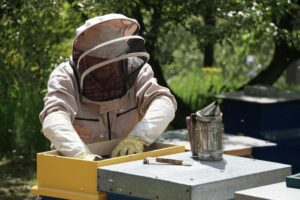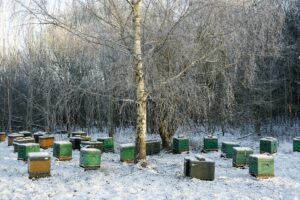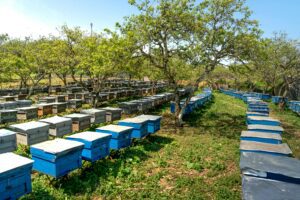In today’s agricultural landscape, beekeepers play a crucial role beyond harvesting honey. They are pivotal in ensuring the health of our ecosystems and the productivity of our crops through their expertise in bee management and pollination practices. This article delves into how beekeepers contribute to agricultural sustainability, from enhancing crop yields through pollination partnerships to fostering biodiversity within farming communities. Understanding their vital role is essential for appreciating the interconnectedness of bees, agriculture, and environmental stewardship. If you are just getting started, check out Beginner’s Guide to Beekeeping: 8 Steps for Starting Your Journey.
Table of Contents

The Vital Role of Bees in Agriculture
Importance of Crop Pollination
- Bees pollinate over 75% of leading global food crops.
- Many fruits, vegetables, and nuts depend on bee pollination for reproduction.
- Increased crop yields and improved fruit quality due to efficient pollination.
Impact on Agricultural Yields
- Studies show crop yields can increase significantly with proper pollination.
- Bee-pollinated crops have higher fruit set and more uniform fruit size.
- Essential for seed production in crops like alfalfa and clover.
Contribution to Crop Quality
- Enhanced flavor, size, and appearance of fruits and vegetables.
- Improved nutritional value due to better fruit development.
- Higher market value for bee-pollinated produce.
Role in Food Security
- Bees contribute to global food security by pollinating a wide variety of crops.
- Pollination ensures stable and diversified food production.
- Helps mitigate food shortages and promotes dietary diversity.
Ecosystem Services Provided by Bees
- Essential for maintaining biodiversity in natural ecosystems.
- Supports habitats for other wildlife species through plant pollination.
- Contributes to ecosystem resilience and adaptation to environmental changes.
Dependence of Agriculture on Bee Pollination
- Many commercial crops rely on insect pollination, with bees being the most efficient.
- Almonds, apples, and blueberries are examples of crops highly dependent on bees.
- Without bees, agricultural productivity and food availability would be severely impacted.
Economic Significance for Farmers
- Bee pollination contributes billions of dollars annually to global crop production.
- Increased crop yields and quality lead to higher profits for farmers.
- Farmers invest in managed hives for improved crop pollination and yield stability.
Challenges Facing Bee Populations
- Pesticide exposure and habitat loss threaten bee populations.
- Parasites and diseases weaken bee colonies.
- Climate change affects bee behavior and foraging patterns.
Challenges Facing Bee Populations
Are Honey Bees Endangered? 5 Key Facts You Need to Know
Pesticide Exposure
- Impact: Harmful effects on bee health and behavior.
- Examples: Neonicotinoids and other agricultural chemicals.
- Mitigation: Advocacy for safer pesticide use and alternative farming practices.
Habitat Loss
- Cause: Urbanization, monoculture farming, and land development.
- Effect: Reduced foraging habitats and nesting sites for bees.
- Solution: Conservation efforts to preserve natural habitats and promote bee-friendly landscapes.
Parasites and Diseases
- Threats: Varroa mites, hive beetles, wax moths, ants, Nosema disease, and other pathogens.
- Impact: Weakened immune systems and colony collapse.
- Management: Integrated pest management (IPM) and treatment strategies.

Climate Change
- Impact: Alters flowering seasons and disrupts bee foraging patterns.
- Consequences: Reduced availability of nectar and pollen.
- Adaptation: Research on climate-resilient beekeeping practices and habitat restoration.
Agricultural Practices
- Risk: Monoculture farming limits bee nutrition diversity.
- Challenges: Reduced biodiversity and increased pesticide exposure.
- Solution: Adoption of sustainable agriculture practices and diversified crop rotations.
Lack of Genetic Diversity
- Issue: Inbreeding within managed bee populations.
- Consequence: Reduced resilience to diseases and environmental stressors.
- Approach: Breeding programs for disease-resistant bee stocks and genetic diversity conservation.
Public Awareness and Policy
- Need: Education on the importance of bees and pollinators.
- Advocacy: Support for policies promoting pollinator conservation.
- Action: Participation in local beekeeping associations and community initiatives.
Beekeepers as Pollination Partners
Enhancing Crop Yields
- Role: Beekeepers facilitate efficient pollination in agricultural settings.
- Impact: Increased fruit set and uniformity in crop production.
- Example: Almonds and apples benefit significantly from managed bee colonies.
Supporting Biodiversity
- Contribution: Beekeepers maintain diverse plant species through pollination.
- Benefit: Enhances habitat quality for wildlife and promotes ecosystem resilience.
- Case Study: Integration of diverse flowering plants in beekeeping practices.
Economic Benefits for Farmers
- Value: Beekeeping services contribute billions to global agricultural economies.
- Return: Higher crop yields and improved quality lead to increased profits.
- Strategy: Farmers integrate beekeepers for reliable pollination services.
Promoting Sustainable Farming
- Practice: Managed bee colonies support sustainable agriculture practices.
- Advantage: Reduces reliance on chemical pollination alternatives.
- Initiative: Adoption of pollinator-friendly farming techniques.
Collaborative Research and Innovation
- Partnership: Beekeepers collaborate with researchers on pollination studies.
- Outcome: Improves understanding of crop-pollinator dynamics.
- Advancement: Innovations in beekeeping technology for enhanced agricultural productivity.
Community Engagement and Education
- Outreach: Beekeepers educate farmers and communities on pollinator importance.
- Awareness: Promotes conservation efforts and sustainable land management.
- Program: Workshops and initiatives drive agricultural sustainability awareness.
Promoting Biodiversity through Beekeeping
Habitat Preservation
- Initiative: Beekeepers maintain diverse landscapes conducive to bee habitats.
- Impact: Supports native flora and fauna populations.
- Example: Incorporation of wildflower meadows and hedgerows on beekeeping properties.
Conservation of Native Pollinators
- Role: Beekeepers advocate for the protection of native bee species.
- Benefit: Enhances pollination diversity and ecosystem resilience.
- Action: Creation of nesting sites and foraging areas for wild bees.
Restoration of Ecosystem Services
- Contribution: Beekeeping activities restore degraded habitats.
- Effect: Improves soil fertility and water retention capabilities.
- Practice: Utilization of regenerative beekeeping practices.
Diversification of Agriculture
- Strategy: Beekeepers integrate pollinator-dependent crops into agricultural rotations.
- Advantage: Enhances crop resilience and reduces pest pressure.
- Example: Integration of bee-pollinated crops like squash and berries in farming systems.
Education and Outreach
- Effort: Beekeepers educate communities on the role of bees in biodiversity.
- Awareness: Promotes sustainable land management and conservation practices.
- Programs: Workshops and educational campaigns drive biodiversity initiatives.
Collaboration with Conservation Organizations
- Partnership: Beekeepers collaborate with conservation groups on biodiversity projects.
- Outcome: Enhances habitat connectivity and species recovery efforts.
- Initiative: Joint initiatives for biodiversity monitoring and restoration.
Sustainable Beekeeping Practices
Integrated Pest Management (IPM)
- Approach: Utilization of biological controls and selective pesticides.
- Benefit: Minimizes chemical exposure and preserves bee health.
- Example: Varroa mite management through non-chemical treatments.
- Read 8 Common Beehive Pests and Effective Prevention Tips for Beekeepers
Habitat Enhancement
- Initiative: Planting native flowering plants and trees around apiaries.
- Impact: Provides diverse foraging opportunities for bees.
- Outcome: Supports overall colony health and productivity.
Seasonal Management Strategies
- Practice: Adjusting hive configurations and supplemental feeding as needed.
- Adaptation: Addresses seasonal variations in forage availability and climate conditions.
- Example: Winter preparation to ensure hive survival and spring buildup.
Genetic Diversity Conservation
- Importance: Maintaining diverse bee populations resistant to pests and diseases.
- Strategy: Breeding programs for local adaptations and resilience.
- Approach: Incorporation of diverse bee genetics through queen rearing practices.

Water Resource Management
- Consideration: Providing access to clean water sources near apiaries.
- Significance: Ensures hydration for bees and supports colony functions.
- Implementation: Placement of water stations with suitable landing platforms.
Energy Efficiency
- Practice: Optimizing hive designs and management techniques for energy conservation.
- Benefit: Reduces carbon footprint and operational costs.
- Example: Use of insulated hive covers and solar-powered equipment.
Pollinator-Friendly Farming
- Integration: Collaboration with farmers for pesticide reduction and habitat preservation.
- Promotion: Encourages adoption of pollinator-friendly crop practices.
- Outcome: Enhances agricultural sustainability and pollination services.
Educational and Outreach Efforts
Community Workshops and Seminars
- Initiative: Organizing educational events on beekeeping fundamentals.
- Objective: Educate aspiring beekeepers and the general public.
- Example: Hands-on hive demonstrations and Q&A sessions.
School Outreach Programs
- Engagement: Partnering with schools to teach students about bees and pollination.
- Activity: Setting up observation hives and interactive lessons on bee biology.
- Impact: Fosters environmental awareness and appreciation for bees.
Farmer Training Programs
- Purpose: Educating farmers on the importance of pollinators in agriculture.
- Content: Workshops on integrating pollinator-friendly practices into farming.
- Outcome: Promotes sustainable farming methods and enhances crop yields.
Online Resources and Webinars
- Accessibility: Providing digital content for beekeepers worldwide.
- Topics: Webinars on advanced beekeeping techniques and pest management.
- Reach: Extends outreach to remote or international audiences.
Public Awareness Campaigns
- Campaign: Advocating for pollinator conservation and sustainable land use.
- Messaging: Highlighting the role of bees in food production and ecosystem health.
- Collaboration: Partnerships with environmental organizations and media outlets.
Policy Advocacy and Engagement
- Role: Participating in policy discussions on pollinator protection and land management.
- Advocacy: Lobbying for bee-friendly regulations and incentives for beekeepers.
- Impact: Influences local and national policies supporting pollinator health.
Research Collaboration
- Partnership: Working with scientists and universities on bee health and ecology studies.
- Research Focus: Investigating bee diseases, genetics, and habitat requirements.
- Application: Translating research findings into practical beekeeping recommendations.
Future Directions and Innovations
Precision Beekeeping Technologies
- Advancement: Integration of sensors and IoT for hive monitoring.
- Application: Real-time data on hive conditions and health indicators.
- Impact: Enhances hive management efficiency and productivity.
Genetic Research and Breeding Programs
- Focus: Developing disease-resistant and climate-adapted bee strains.
- Objective: Improving colony resilience and genetic diversity.
- Outcome: Supports sustainable beekeeping practices and bee health.
Sustainable Hive Design
- Innovation: Development of eco-friendly hive materials and designs.
- Features: Enhances thermal regulation and energy efficiency.
- Benefits: Reduces environmental impact and operational costs.
Pollinator Pathways and Habitat Restoration
- Initiative: Establishing corridors and native plantings for pollinator connectivity.
- Purpose: Promotes biodiversity and enhances forage availability.
- Collaboration: Partnerships with conservation groups and landowners.
Beekeeping Education and Training
- Expansion: Scaling up educational programs for beekeepers globally.
- Content: Incorporation of digital learning tools and virtual training modules.
- Impact: Empowers beekeepers with knowledge and skills for sustainable practices.
Climate Resilience Strategies
- Adaptation: Developing strategies to mitigate climate change impacts on bees.
- Research: Studying bee behavior and foraging patterns under changing conditions.
- Implementation: Promotes resilience in beekeeping practices and ecosystem services.
Public Engagement and Advocacy
- Campaigns: Raising awareness about the importance of bees and pollinators.
- Policy Influence: Advocating for policies supporting pollinator-friendly practices.
- Community Involvement: Engaging stakeholders in conservation and sustainability efforts.
Other Resources
USDA PROGRAMS AND RESOURCES TO SUPPORT BEEKEEPERS
Conclusion: Beekeepers’ Contribution to Agricultural Sustainability
Beekeepers play a pivotal role in agricultural sustainability by fostering pollination, biodiversity, and ecosystem health. Through their dedication to sustainable practices and continuous innovation, beekeepers not only ensure the vitality of bee populations but also enhance crop yields and quality. Their efforts in education, research collaboration, and advocacy contribute to shaping policies that protect pollinators and promote environmental stewardship. As we look to the future, the role of beekeepers remains crucial in safeguarding our food systems and nurturing a sustainable relationship between agriculture and nature.



